Disclaimer:
”Explanation to Political Parties Class 10” is a comprehenive explanantion to political parites chapter to your class 10 cbse syllabus chapter number 4.
So, while reading the “Explanation to Political Parties Class 10” you should not try to memorise anything. You just need to take a vibe of the chapter by trying to understand and get an idea of the chapter.
I have tried hard to to explain the concepts as easy as possible.
but if you find something diffucult to understand then please comment and contact me.
let’s dive in.
Imagine Your School Project Group… But Bigger! 🏫
You know how in group projects, everyone has different ideas? One wants posters, another wants a PPT, and someone just wants to nap 😴. A political party is like that group—but scaled up to run a country. Let’s unravel what they really are!
Table of Contents
Meaning of Political Parties: Breaking It Down! 🎯
What’s a political party?
A political party is not just a bunch of people shouting on TV. Let’s define it properly:
- Group Goal: A team of people who come together to:
- Contest elections 🗳️
- Hold power in the government 🏛️
(Think of them as the “class monitors” competing to lead the school!)
- Shared Vision: They agree on policies for society’s “collective good.”
- Example: One party might push for free college education 🎓, another for better highways 🛣️.
- Partisanship: They’re part of society, not the whole. So, they fight for their “part” (farmers, students, businesses, etc.).
- “You can’t please everyone, but you can stand for someone.”
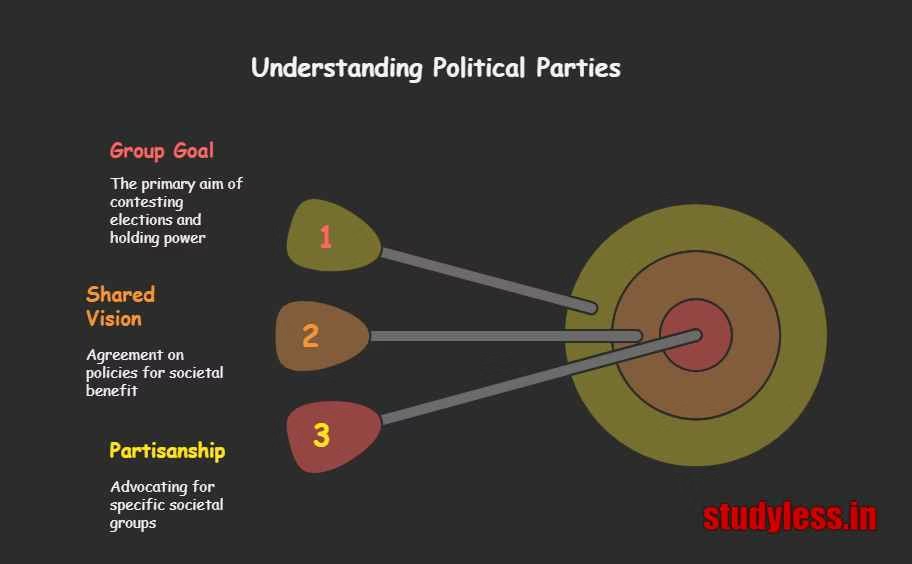
The 3 Key Ingredients of a Party:
- Leaders 👩💼: The face of the party (e.g., PM candidates).
- Active Members 🙋♂️: The ground workers (organizing rallies, solving local issues).
- Followers 👥: You and me! Supporters who vote, attend meetings, or share party posts on WhatsApp.
Fun Metaphor:
A political party is like Zomato for governance 🍲. They “deliver” policies based on what their “customers” (voters) order!
Why Do Parties = Political Divisions? 🤝 vs. 🔪
Parties reflect society’s splits—rich vs. poor, urban vs. rural, secular vs. religious. For example:
- Party A: “Tax the rich to fund schools!”
- Party B: “Let businesses grow to create jobs!”
This isn’t bad—it’s democracy’s way of balancing voices. But yes, it can get messy (like family WhatsApp groups 🥴).
Quick Check:
If parties represent “parts” of society, can there ever be a party that represents everyone?
So, we’ve cracked the code on what political parties are… but what do they actually do? 🤨
Imagine you’re watching a cricket match. You know the players, their jerseys, and their slogans. But if they just stood on the field doing nothing—no batting, no bowling, no fielding—would you keep watching? 🏏
Parties aren’t just names and symbols. They’re the backstage crew of democracy’s blockbuster movie. But here’s the twist: What if their job description is way wilder than you think? 💥
(Hint: It’s not just about winning elections. Let’s uncover the secret playbook…)
Curious? Let’s dive into the REAL work parties do—and why your chai-wala uncle has opinions about it. ☕👉
What Do Political Parties Actually DO? Let’s Unpack Their Jobs! 🛠️
Functions Of Political Parties 🏏
You know how your school’s cricket team isn’t just about wearing cool jerseys? They practice, plan strategies, and play to win. Political parties do the same—but their “tournament” is running a country! Let’s break down their 7 core functions (spoiler: it’s not just arguing on TV).
1. Contest Elections: The Ultimate Talent Show 🎤
Parties are democracy’s contestants. Without them, elections would be chaos—like 5,000 independent candidates fighting for one seat!
- How they pick candidates:
- USA: Party members vote (like a reality show audience!).
- India: Top leaders choose (think of it as “coach’s selection”).
Fun Fact: In 2019, 8,054 candidates ran for 543 Lok Sabha seats. Imagine voting if all were independents! 😱
2. Shape Policies: From Hashtags to Laws 📜
Parties turn vague slogans (“Education for all!”) into actionable plans (“Free laptops for Class 12 students”).
- Why this matters: You can’t have 1.4 billion opinions. Parties bundle similar ideas (like playlists!) to give governments direction.
Real Example: Congress introduced MNREGA (100 days of work), BJP pushed Swachh Bharat. Both shaped national priorities.
3. Make Laws: The Parliament Factory 🏭
Laws aren’t just debated by MPs—they’re steered by parties.
- Behind the scenes: MPs usually vote as their party says, even if they personally disagree.
- Ever seen a ruling party MP rebel? Rare, right?
Metaphor: Parties are the “scriptwriters” of democracy’s drama.
4. Form Governments: From Players to Captains 🏆
Winning parties don’t just celebrate—they build teams:
- Recruit leaders → Train them → Make them ministers.
- Example: Modi’s cabinet (2019) had leaders groomed by BJP for years.
Quick Check:
If independents won all seats, how would a government form? (Chaos alert! 🚨)
5. Play Opposition: Democracy’s Watchdogs 🐕
Lost an election? Your job is to scrutinize the winners:
- Ask tough questions (“Why are onions so expensive?!”).
- Mobilize protests (like Rahul Gandhi’s Bharat Jodo Yatra).
Quote: “A strong opposition keeps the government on its toes.” – Atal Bihari Vajpayee
6. Shape Public Opinion: Trendsetters of Politics 📢
Parties don’t just follow trends—they create them:
- Highlight issues (farmers’ protests, LGBTQ+ rights).
- Use members and allies (student wings, labor unions) to spread their message.
Example: AAP’s “Bijli-Paani Satyagraha” in Delhi made electricity/water key voter issues.
7. Connect You to the Government: The “Local Leader” Hotline 📞
Need a ration card fixed? You’ll likely call a party worker, not a bureaucrat!
- Why: Parties simplify access to schemes (PM-KISAN, Ayushman Bharat).
- Catch: They’ll help you… but expect your vote in return!
Activity:
Ask your parents: Have they ever approached a local party leader for help? What happened?
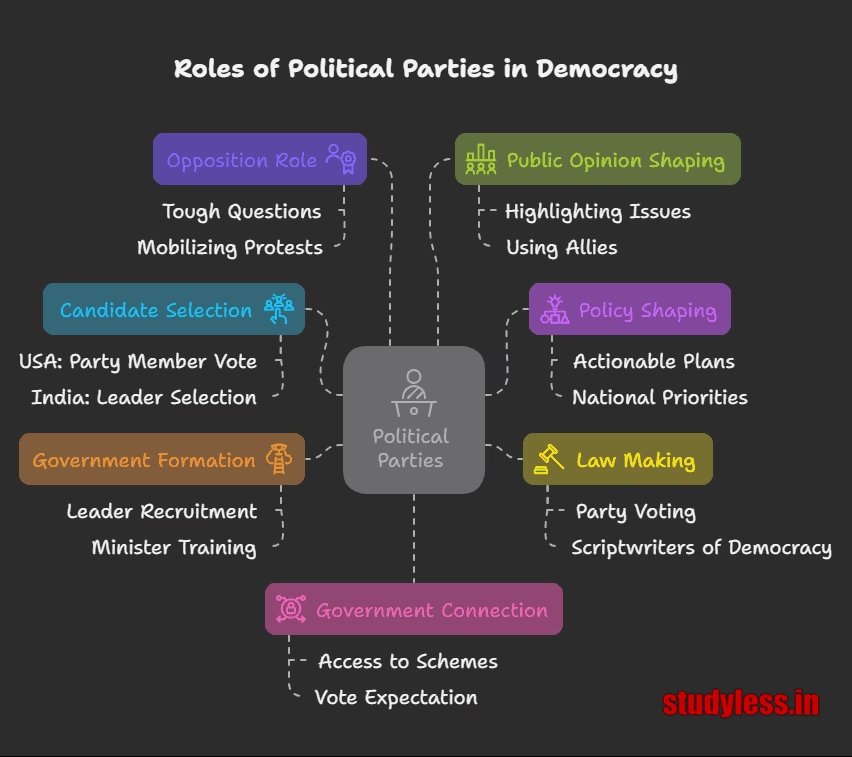
Quiz Time! Test Your Party IQ 🧠
- Assertion-Reason:
A: Parties reduce 1.4 billion opinions into clear policies.
R: They group similar public demands to guide governments.
a) Both true, R explains A ✅
b) Both true, R ≠ A - MCQ: Who trains and recruits ministers?
a) Bureaucrats
b) Political parties ✅
c) The President - Debate:
Is the opposition’s job to “criticize” or “collaborate”? Where’s the line? 💬
So, parties do all this heavy lifting—but here’s the million-rupee question: What if we hit DELETE? 🚫
Imagine your smartphone without apps. Sure, it’s possible to survive… but you’d miss WhatsApp, Instagram, and Zomato. Now scale that up: Could democracy function without parties?
- Would elections become a Tinder swipe of random candidates? ❓
- Would laws be decided by… Twitter polls? 🐦
Here’s the twist: Even the harshest party critics rely on them. Why? Because without parties, democracy isn’t just messy—it’s unrecognizable.
Ready to uncover why parties aren’t just “useful”—they’re democracy’s oxygen? Let’s spill the chai… ☕💥
Why Can’t Democracies Survive Without Political Parties? Let’s Find Out! 🌍
So, parties do everything from shaping policies to keeping governments in check. But here’s the twist: Imagine a democracy without them. Sounds peaceful? Think again!
Picture a classroom where every student is the teacher—no rules, no syllabus, just chaos. That’s democracy without parties. Let’s decode why they’re non-negotiable!
Why Parties Are Democracy’s Oxygen 💨/Why Political Parties Are Necessary
1. No Parties = No Promises, No Accountability 🚫
If every candidate were independent:
- No major reforms: Who’ll promise GST, farm laws, or free education?
- Local focus only: Your MP might fix potholes but ignore national crises like inflation.
- Chaotic governance: Imagine 543 freelancers trying to agree on a budget!
Quote:
“Democracy is the art of choosing your poison. Without parties, it’s just poison.” – Adapted from Winston Churchill
2. The Panchayat Paradox: Even “Non-Party” Elections Have Hidden Parties 🏡
In many states, panchayat elections are “non-party.” But guess what? Villages split into factions (Team A vs. Team B), each acting like a mini-party.
- Reality check: Humans naturally form groups to push agendas. Parties are inevitable!
Real Example:
In West Bengal’s panchayat polls, factions backed by TMC, BJP, or Left clash—proving parties exist even when “banned.”
3. Societies Need Organizers, Not Chaos 🏙️
As countries grow:
- Diverse opinions → Need a megaphone (parties gather similar views).
- Accountability → Need a target (blame the ruling party, not 543 individuals).
- Stability → Need a playbook (parties offer long-term agendas).
Quote:
“The alternative to political parties is not democracy—it’s anarchy.” – E.E. Schattschneider
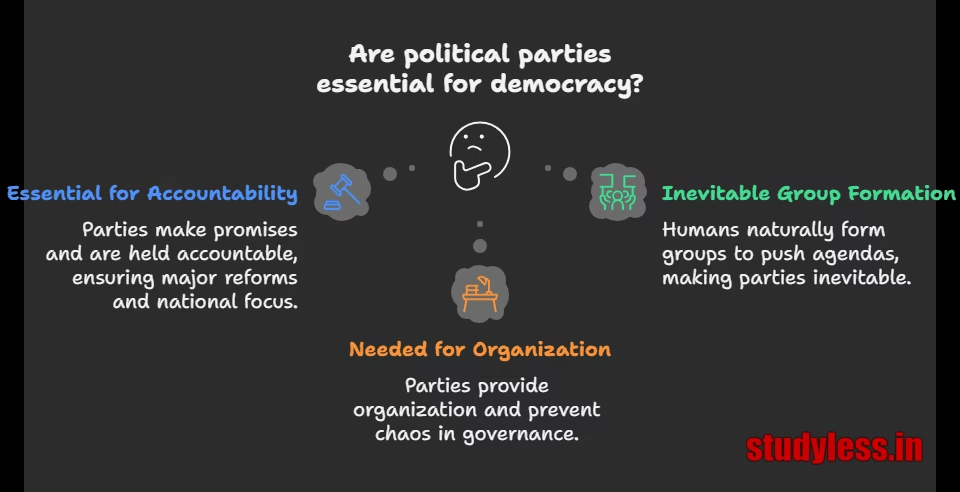
The BIG Debate: How Many Parties Should a Democracy Have? 🤼
India has 2,658 parties! 🇮🇳
The US has two. 🇺🇸 China has one (but it’s not democratic). So, what’s the ideal number?
Let’s explore next:
- Is a two-party system (like the US) cleaner but less diverse?
- Does a multi-party system (like India) represent more voices but create messy coalitions?
- Can a one-party system ever be truly democratic?
Quote:
“A democracy without choice is like a menu without dishes. But too many dishes spoil the meal.” – Anonymous
Quiz: Test Your Party IQ 🧠
- Assertion-Reason:
A: Panchayat elections show parties are unavoidable.
R: Humans naturally form groups to compete for power.
a) Both true, R explains A ✅
b) Both true, R ≠ A - MCQ: Why can’t independents ensure national accountability?
a) They focus only on local issues ✅
b) They hate the Prime Minister
c) They can’t use social media - Debate:
Is a one-party democracy possible, or is that an oxymoron? 💬
So, parties are essential… but here’s the billion-dollar question: How many is too many?
Imagine a pizza with 100 toppings 🍕—exciting or overwhelming? Now replace “toppings” with “parties.”
- Two-party systems = Cheese and pepperoni (simple, but boring).
- Multi-party systems = Everything from pineapple to anchovies (chaotic, but inclusive).
What’s better for democracy? Let’s slice through the debate next…
How Many Parties Should a Democracy Have? Let’s Explore the Flavors! 🍕
We’ve established that parties are democracy’s backbone. But here’s the spicy debate: How many parties are too many?
Imagine a food court with only pizza (boring!) vs. one with 100 cuisines (overwhelming!). Democracy’s party system works the same way. Let’s unpack the three flavors of party systems and why India chose the “thali” model!
Types Of Party Systems : One, Two, or Many? 🎯
1. One-Party System: The “No Choice” Meal 🚫
- Example: China (only the Communist Party rules).
- Reality Check: Legally, you can form parties, but practically, you can’t win.
- Why it’s undemocratic: “Democracy is about options, not monopolies.” – Adapted from Nelson Mandela
Quick Fact: North Korea’s Workers’ Party has ruled since 1948. No elections, no opposition.
2. Two-Party System: The “Burger vs. Pizza” Duel 🍔 vs. 🍕
- Examples: USA (Democrats vs. Republicans), UK (Conservatives vs. Labour).
- Pros: Stable governments, clear choices.
- Cons: Marginalizes smaller voices (e.g., environmentalists, LGBTQ+ groups).
Quote:
“In a two-party system, voters often pick the lesser evil, not the greater good.” – Anonymous
Indian Context: Ever wondered why India didn’t adopt this? Our diversity refuses to fit into two boxes!
3. Multi-Party System: The Democracy “Thali” 🍛
- Example: India (8 national parties, 50+ state parties, 2,600+ registered!).
- How it works: Parties form alliances (NDA, UPA) to get majority seats.
- Pros: Represents caste, region, language, and ideology.
- Cons: Slow decisions, unstable coalitions (remember 1996-1998? 3 PMs in 2 years!).
Real Talk:
Why India needs it: A Tamil farmer, a Punjabi entrepreneur, and a tribal artist can’t all fit into two parties.
Fun Metaphor:
Multi-party democracy = Spotify playlist 🎧. You get everything from classical to punk!
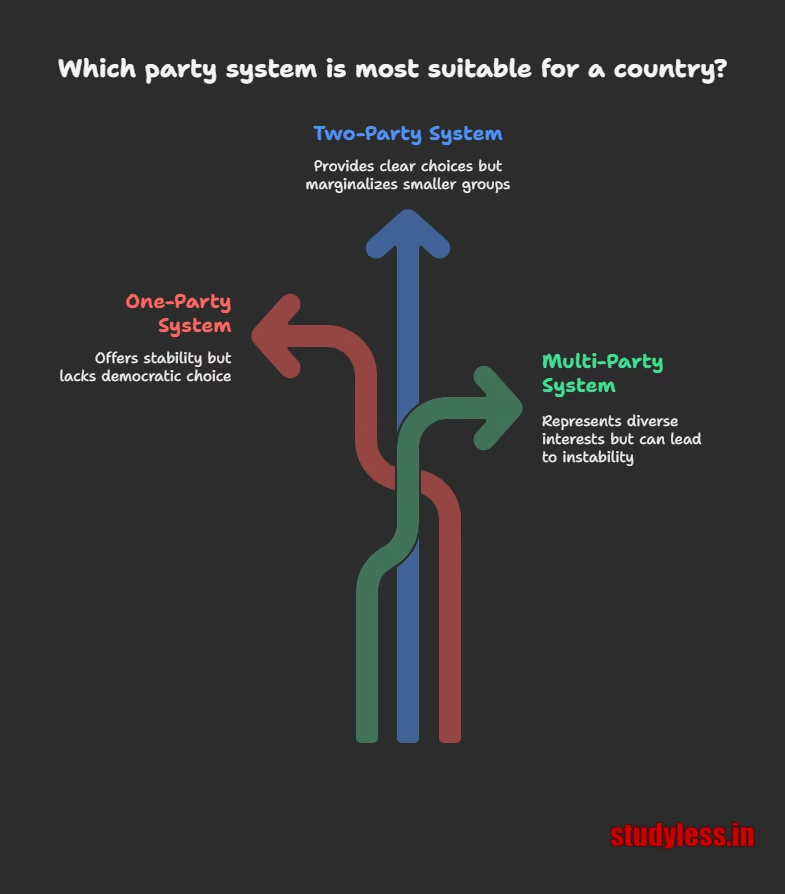
Wait, Can’t We Just Choose a System? 🤷♀️
Nope! Party systems evolve like regional cuisines:
- USA’s two-party system: Born from a history of two dominant ideologies.
- India’s multi-party chaos: Shaped by caste, religion, language, and maa ke haath ka khana diversity.
Quote:
“India is not a country, it’s a universe. How can two parties govern a galaxy?” – Adapted from Shashi Tharoor
Quiz: Test Your Party Savvy! 🧠
- MCQ: Which country has a one-party system?
a) India
b) China ✅
c) UK - Assertion-Reason:
A: Multi-party systems are unstable.
R: They represent too many diverse interests.
a) Both true, but R doesn’t explain A ❌
b) Both true, and R explains A ✅ - Debate:
Is India’s multi-party system a strength or a weakness? Argue with a friend! 💬
So, India’s political “thali” has national parties (like BJP, Congress) and regional ones (like DMK, Shiv Sena). But what makes a party “national”?
Imagine Flipkart vs. your local kirana store 🏪. Both matter, but one has a pan-India reach. How do parties earn the “national” tag? Let’s decode the recipe…
National Parties in India – The Big Players of Democracy! 🏛️
We’ve seen India’s political “thali” has a mix of national and regional flavors. Now, let’s zoom in on the national parties—the big franchises of Indian politics, like McDonald’s or Starbucks, but with election symbols instead of burgers! 🍔➡️🎪
What Makes a Party “National”? 🎯
National parties are the pan-India heavyweights. To earn this tag, they must:
- Have a presence in multiple states.
- Meet strict Election Commission (EC) criteria (votes + seats).
EC Recognition Criteria:
| Category | State Party | National Party |
| Vote Share | 6% in one State Assembly election | 6% in four State elections OR 6% in Lok Sabha + 4 seats |
| Seats Required | 2 seats in State Assembly | 4 seats in Lok Sabha OR 2% of Lok Sabha seats from 3+ states |
Example: BJP is national; Shiv Sena is a state party (Maharashtra).

Meet India’s National Parties (2023)
As of 2023, India has 6 recognized national parties. Let’s spotlight two key players:
1. Communist Party of India (Marxist) – CPI(M)
| Symbol | Founded | Ideology | Strongholds | 2024 Lok Sabha Seats |
| Hammer, Sickle, Star | 1964 | Socialism, Workers’ Rights | West Bengal, Kerala, Tripura | 3 seats |
Key Traits:
- Fights for farmers, laborers, and against “foreign capital”.
- Ruled West Bengal for 34 years straight (1977–2011).
- Criticizes BJP’s economic policies.
Quote:
“The CPI(M) isn’t just a party; it’s a movement for the oppressed.” – Prakash Karat
2. Indian National Congress (INC)
| Symbol | Founded | Ideology | Strongholds | 2024 Lok Sabha Seats |
| Hand | 1885 | Secularism, Welfare | Pan-India (weaker now) | 52 seats |
Key Traits:
- Oldest party in India (founded pre-independence!).
- Built India as a secular, democratic republic under Nehru.
- Led UPA govt (2004–2014) with focus on MNREGA, RTI.
Fun Fact:
The INC’s “hand” symbol is one of India’s most recognized logos—even grandma knows it! 👵
Why Do National Parties Matter? 🌟
- Unity in Diversity: They bridge regional divides (e.g., Congress in North & South).
- Stability: National agendas (e.g., GST, Aadhaar) need pan-India support.
- Accountability: You can blame/praise one party for national issues (not 50 regional ones!).
Quick Quiz:
- MCQ: Which national party ruled West Bengal for 34 years?
a) BJP
b) CPI(M) ✅
c) AAP - Assertion-Reason:
A: National parties need a 6% vote share in four states.
R: They must represent diverse regional interests.
a) Both true, R explains A ✅
b) Both true, R ≠ A
But what about parties that rule one state like masters of their own kingdom? 🏰
| National Parties | State Parties |
| Pan-India presence (e.g., BJP) | Regional focus (e.g., DMK in Tamil Nadu) |
| Agenda: National issues | Agenda: Language, culture, local demands |
| EC criteria: Strict | EC criteria: State-specific |
Next Up: Why DMK, TMC, or Shiv Sena punch above their weight in Indian politics! Stay tuned…
State Parties – The Powerhouses Behind India’s Political Diversity! 🎪
We’ve seen how national parties like BJP and Congress dominate the big stage. But what about the state parties—the kingmakers who rule regional roosts and shape national politics? Imagine Netflix teaming up with local filmmakers to create blockbusters. That’s India’s coalition politics! Let’s decode these regional giants.
What Are State Parties? 🌾
State (or regional) parties are masters of their turf, focusing on local issues, culture, and identity. But don’t call them “small”—many punch above their weight in national politics!
Election Commission Criteria for State Parties:
| Parameter | State Party | National Party |
| Vote Share | 6% in one State Assembly election | 6% in four states OR 6% in Lok Sabha + 4 seats |
| Seats Required | 2 seats in State Assembly | 4 seats in Lok Sabha OR 2% of LS seats from 3+ states |
Example:
- Shiv Sena (Maharashtra): Fights for Marathi pride.
- DMK (Tamil Nadu): Champions Tamil language and autonomy.
State Parties vs. National Parties: Spot the Difference! 🔍
| Aspect | State Parties | National Parties |
| Focus | Regional issues (language, water disputes) | National agendas (defense, GST) |
| Presence | 1-2 states | Multiple states |
| Role in Govt | Kingmakers in coalitions | Lead alliances |
| Example | TMC (West Bengal), TRS (Telangana) | BJP, Congress |
Fun Fact: Until 2014, no national party won a Lok Sabha majority alone! Coalitions needed state parties like SP, DMK, or JDU.
Why State Parties Rock! 💥
- Voice for Regional Identity:
- Biju Janata Dal (BJD): Pushes Odia culture and anti-Central neglect.
- Mizo National Front (MNF): Secured peace in Mizoram.
- Coalition Power:
- 1996-2014: Era of coalition govts (Third Front, UPA, NDA). State parties like DMK, TMC, and Akali Dal became kingmakers.
- Example: TMC’s Mamata Banerjee often dictates terms to BJP/Congress on key bills.
- Strengthen Federalism:
- Force national parties to listen to states.
- 2015 Land Bill: Opposition from state parties forced BJP to backtrack.
Quote:
“India’s states are its soul. State parties ensure that soul isn’t ignored.” – M. Karunanidhi
State Parties: Beyond “Regional” Labels 🏷️
Some state parties have national ambitions:
- Samajwadi Party (UP): Socialist ideology, eyeing Hindi heartland influence.
- Rashtriya Janata Dal (Bihar): Fights for backward castes nationally.
But others stay hyper-local:
- Sikkim Democratic Front: Focuses on tribal rights and eco-tourism.
- Telangana Rashtra Samithi (TRS): Born from Telangana statehood movement.
Quiz: Test Your State Party Savvy! 🧠
- MCQ: Which state party is linked to Telangana’s creation?
a) DMK
b) TRS ✅
c) Shiv Sena - Assertion-Reason:
A: State parties strengthen federalism.
R: They force national parties to address regional issues.
a) Both true, R explains A ✅
b) Both true, R ≠ A - Debate:
Can a state party like TMC ever replace Congress as a national force? 💬
But here’s the twist: State parties aren’t all heroes. With great power comes… horse-trading, defections, and identity politics.
Imagine a football team where players keep switching sides for money 🤑. That’s the dark side of coalition politics. Why do parties—national and state—struggle with corruption, dynasties, and public distrust? Let’s tackle the ugly truths next…
Challenges to Political Parties – Why Are They Struggling? 🚨
We’ve seen how state and national parties shape democracy. But let’s face it: parties today are like a popular restaurant with terrible hygiene ratings. Everyone loves their “dishes” (manifestos), but the kitchen (internal workings) is a mess. Let’s dissect the four big challenges plaguing political parties.
Challenge 1: Lack of Internal Democracy 🗳️
What’s the Issue?
Imagine your school’s student council, but only the principal’s favorite students make all decisions. That’s how many Indian parties function! Power is concentrated in a few top leaders, leaving ordinary members in the dark.
Indian Examples:
- Congress: The Gandhi family’s dominance often overshadows grassroots voices.
- BJP: While more structured, key decisions (like PM candidacy) are centralised.
- Regional Parties: Akhilesh Yadav (Samajwadi Party) or Uddhav Thackeray (Shiv Sena) inherited leadership, sidelining internal elections.
Impact:
- Loyalty to leaders, not principles.
- Young leaders like Jyotiraditya Scindia quit parties (he left Congress in 2020) due to stifled growth.
| Problem | Definition | Example | Impact |
| Power Centralization | Top leaders control decisions; members have no say. | BJP’s PM candidate chosen by top brass. | Grassroots workers feel ignored. |
| No Internal Elections | Parties skip member voting for leadership roles. | Congress’s leadership often “inherited”. | Leaders lack accountability. |
| Closed-door Functioning | No transparency in funds, tickets, or policies. | Regional parties like TMC in Bengal. | Public distrust grows. |
Quote:
“A party without internal democracy is a ship without a compass—it sails, but no one knows where.” – Anonymous
Challenge 2: Dynastic Succession 👑
What’s the Issue?
Parties become family businesses. If your last name isn’t Gandhi, Yadav, or Thackeray, climbing the ladder feels like scaling Everest without oxygen!
Indian Examples:
- Gandhi Dynasty: Rahul Gandhi (Congress) follows Indira, Rajiv, and Sonia.
- Yadav Clout: Mulayam → Akhilesh (Samajwadi Party); Lalu → Tejashwi (RJD).
- Thackeray Legacy: Balasaheb → Uddhav → Aaditya (Shiv Sena).
Impact:
- Merit takes a backseat. Example: Varun Gandhi (BJP) inherited politics, not grassroots experience.
- Frustrated leaders form splinter groups (e.g., Shinde faction in Shiv Sena).
| Problem | Definition | Example | Impact |
| Family Monopoly | Top posts reserved for a single family. | Gandhi family in Congress, Yadavs in SP. | Talented outsiders quit. |
| No Meritocracy | Loyalty > Competence. | Akhilesh Yadav (SP) replacing Mulayam. | Inexperienced leaders make bad decisions. |
| Undemocratic Culture | Ordinary workers can’t rise. | NCP’s Sharad Pawar promoting his daughter. | Party becomes a “family business”. |
Did You Know?
In 2024, 40% of Lok Sabha MPs from major parties are dynasts!
Challenge 3: Money & Muscle Power 💰💪
What’s the Issue?
Elections in India are a rich man’s game. Parties field crorepatis and criminals who can fund campaigns or intimidate voters.
Indian Examples:
- 2024 Lok Sabha: 29% MPs face criminal charges (murder, extortion).
- Corporate Influence: Electoral Bonds (now scrapped) let companies anonymously fund parties.
- Cash-for-Tickets: Wealthy candidates like Naveen Jindal (BJP) or DK Suresh (Congress) get tickets over grassroots workers.
Impact:
- Policies favor corporates (e.g., farm laws 2020).
- Goons like Mukhtar Ansari (BSP) won elections from jail!
| Problem | Definition | Example | Impact |
| Criminal Candidates | Parties field candidates with criminal records. | 2020 Bihar elections: 29% candidates had criminal cases. | Lawmakers become lawbreakers. |
| Corporate Influence | Big donors shape policies. | Electoral bonds favoring BJP (2017–2024). | Policies favor corporates over the poor. |
| Expensive Elections | Cost to win LS seat: ₹20–30 crore. | AAP’s 2022 Punjab campaign overspending. | Only the rich can contest. |
Shocking Stat:
In 2019, 43% of Lok Sabha MPs were crorepatis. The average asset: ₹20.9 crore!
Challenge 4: No Real Choices for Voters 🗳️❌
What’s the Issue?
Parties now resemble same-same but different food stalls. Whether BJP or Congress, economic policies are neoliberal. Regional parties flip ideologies for power.
Indian Examples:
- BJP vs Congress: Both support privatization, GST, and FDI. Differences? Mostly Hindutva vs secularism rhetoric.
- Ideological U-Turns: Nitish Kumar (JDU) allies with BJP→RJD→BJP again!
- Aap Ki Adalat: AAP, born as anti-corruption, now faces similar graft charges.
Impact:
- Voters pick “lesser evil” (e.g., 2024 Modi vs Rahul, not policy-driven).
- Youth apathy: “Why vote? All parties are the same!”
| Problem | Definition | Example | Impact |
| Similar Manifestos | All parties promise freebies, jobs, and growth. | BJP & Congress both push welfare schemes. | Voters feel no difference. |
| Leader Swapping | Politicians switch parties for power. | Jyotiraditya Scindia (Congress → BJP). | Ideology becomes meaningless. |
| Decline of Ideology | Left vs. Right divide blurs. | CPI(M) supporting neoliberal policies. | Confused voters. |
Quote:
“When all parties sing the same tune, democracy becomes a broken record.” – Adapted from George Orwell
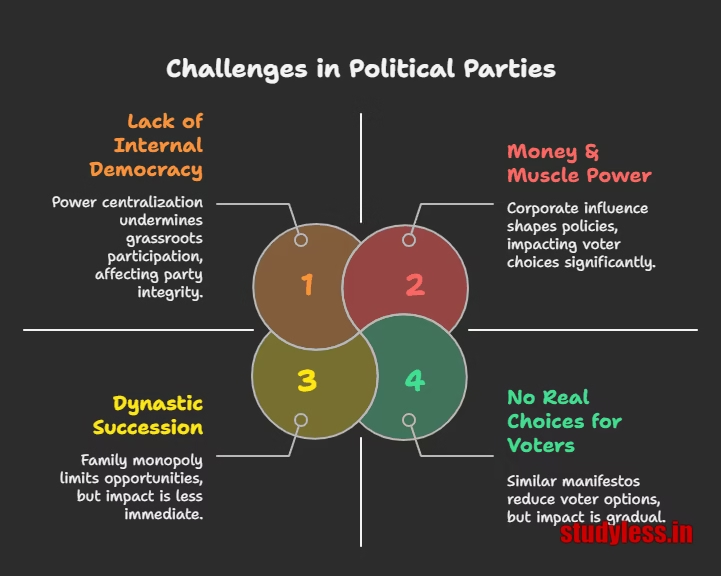
Quick Review: Challenges at a Glance 📋
| Challenge | Root Cause | Consequence |
| Internal Dictatorship | Power hoarded by top leaders | Members revolt; party splits. |
| Dynasty Rule | Family > Merit | Talent drain; weak leadership. |
| Money Talks | Elections = Auction | Criminalization; policy corruption. |
| Fake Choices | Copycat manifestos | Voter apathy; low turnout. |
Quiz: Test Your Awareness! 🧠
- MCQ: Which challenge is highlighted by politicians switching parties?
a) Dynastic Succession
b) No Real Choices ✅
c) Money Power - Assertion-Reason:
A: Dynastic succession harms democracy.
R: It blocks ordinary workers from leadership roles.
a) Both true, R explains A ✅
b) Both true, R ≠ A - Debate:
Should parties with criminal candidates be banned? Why/Why not? 💬
So, parties are drowning in these challenges. But here’s the good news: They’re not incurable!
Imagine a doctor diagnosing a patient—democracy’s prescription includes anti-corruption laws, inner-party elections, and voter awareness. But how?
- Can we ban dynasties like the Gandhis?
- Should elections be state-funded to curb money power?
- What if parties faced mandatory audits?
Ready to explore the fixes? Let’s rewrite the rulebook next…
How Can Political Parties Be Reformed? Let’s Fix the Engine of Democracy! 🔧
We’ve diagnosed the problems—internal dynasties, money power, fake choices. Now, let’s explore the repair manual! Can we fix parties, or is democracy doomed to sputter? Buckle up; we’re diving into solutions!
Attempted Reforms: What’s Been Done? 📜
Here’s a table of key reforms already implemented in India and their mixed results:
| Reform | Problem Addressed | Status | Impact | Challenges |
| Anti-Defection Law | Party-hopping for power/money | ✅ Active | Reduced defections (e.g., 2022 Maharashtra crisis stalled). | Stifles dissent; MPs = puppets. |
| Affidavits for Candidates (Supreme Court) | Criminal & money power | 📋 Partial | Voters get criminal/asset info. | No verification; fake affidavits. |
| EC’s Internal Elections | Lack of inner democracy | ❌ Weak | Parties pretend to hold elections. | Formality (e.g., Congress’s Gandhi family dominance). |
Quote:
“Laws can bind parties, but not their loophole.” – Adapted from Ambedkar
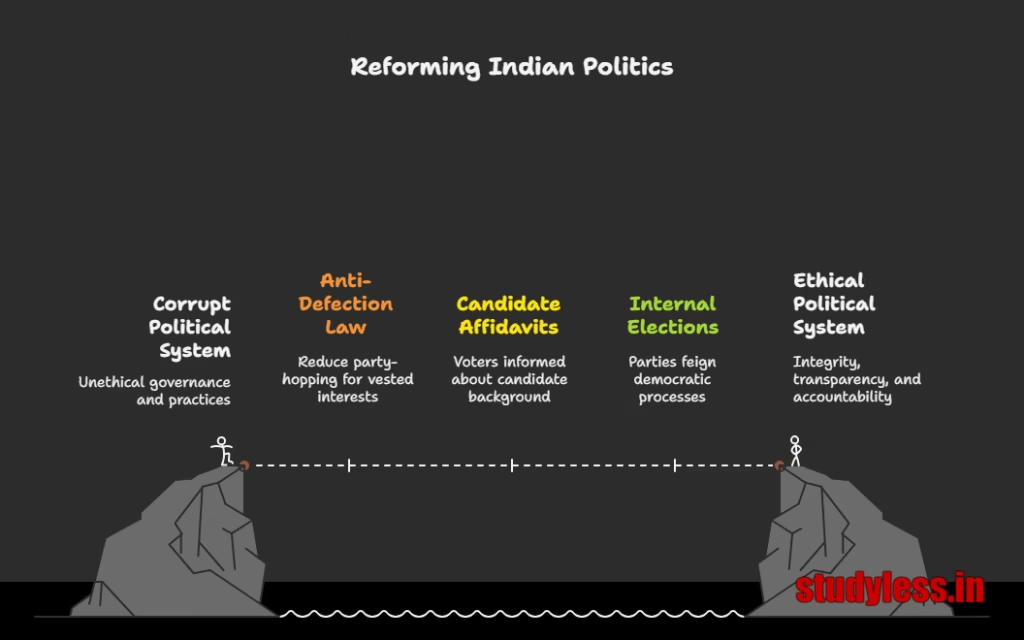
Suggested Reforms: The Wishlist 🛠️
Here’s a table of proposed solutions and why parties resist them:
| Proposed Reform | Goal | Why Parties Resist | Potential Impact |
| Mandatory Internal Democracy | End dynasty rule | Leaders don’t want to share power. | Merit-based leadership (e.g., AAP’s early days). |
| 1/3 Tickets to Women | Gender equality | Patriarchal setups (e.g., BJP/Congress have <15% women MPs). | More Mamatas, Mehboobas, and Smritis. |
| State Funding of Elections | Reduce corporate influence | Parties love black money (₹20K crore spent in 2019 LS polls!). | Cleaner elections; fewer favors to corporates. |
Fun Fact:
Only 14% of Lok Sabha MPs are women. Countries like Rwanda (61%) show quotas work!
The Reform Roadmap: Beyond Laws 🗺️
| Approach | How It Works | Example |
| Public Pressure | Protests, media, petitions. | Anna Hazare’s 2011 movement for Lokpal. |
| Join & Change from Within | Youth enter parties. | Rahul Gandhi’s “Young Congress” revival attempt. |
| Vote Wisely | Reward reformed parties. | Delhi voters backing AAP for transparency (2015). |
Quote:
“Democracy isn’t a spectator sport. You gotta play to fix it.” – Barack Obama
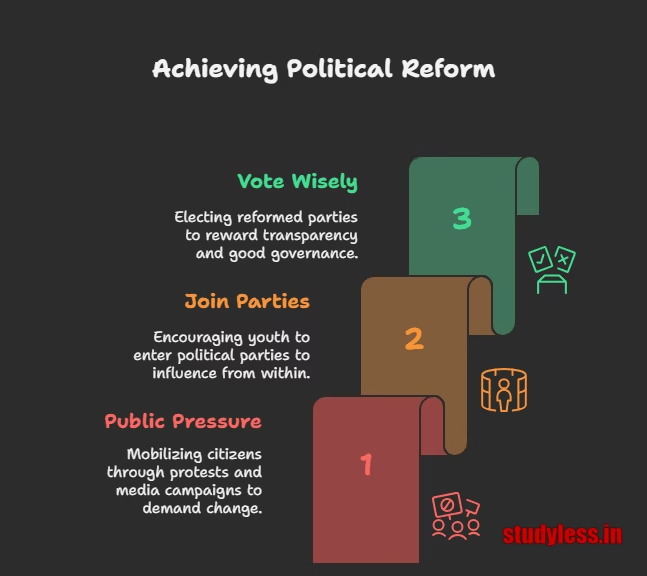
Why Reforms Fail: The Ugly Truth 🚩
| Hurdle | Example | Result |
| Self-Interest | Parties won’t ban dynasties (Gandhis, Thackerays). | Status quo continues. |
| No Enforcement | EC can’t punish affidavit lies. | Criminals still contest (34% of MPs have cases). |
| Public Apathy | Low voter turnout (67% in 2019). | Parties ignore reform demands. |
Quiz: Test Your Reform IQ! 🧠
- MCQ: Which reform mandates candidates to declare assets/criminal records?
a) Anti-Defection Law
b) Affidavit System ✅
c) State Funding - Assertion-Reason:
A: State funding of elections can reduce corporate influence.
R: Parties won’t need donations if govt funds them.
a) Both true, R explains A ✅
b) Both true, R ≠ A - Debate:
Should dynastic politics be banned by law? Why/Why not? 💬
Final Takeaway: Reform Starts With YOU! 🌟
Parties won’t change unless we force them. Whether it’s joining a party, voting wisely, or shaming dynasts on Twitter/X—every action counts.
Your Task:
Next election, check your candidate’s affidavit on https://affidavit.eci.gov.in. Share it on social media if they’re crooked! 🕵️♂️
You may also like our explanantion to Federalism
Why We Need Political Parties
We need political parties to form government and frame laws and policies for us.
Is political Parties Class 10 ,A Important Chapter
Yes it is. Every year a good number of questions are asked.
What is a political party and what are its main parts?
A political party is basically a group of people who come together to contest elections and try to run the government. They usually share the same views on how things should work in the country and create plans (or policies) to improve society. Every political party has three key parts:
Leaders who make the big decisions and guide the party
Active members who work behind the scenes and on the ground
Supporters who believe in the party’s ideas and vote for it
Why do we need political parties in a democracy?
Good question! Political parties make democracy work. They bring people’s voices together and turn them into real plans. They help voters choose between different policies and leaders during elections. Parties also run the government, make laws, and train future leaders. Even the parties that lose elections are important—they act as the opposition, keeping the ruling party in check. Without political parties, it would be really hard to form a government or make big decisions.
What do political parties actually do?
They do a lot more than just fight elections! Here are their main jobs:
Choose candidates and contest elections
Offer different plans (policies) for how the country should be run
Help make laws once they win power
Form and run the government
Act as the opposition if they lose, by questioning and challenging the ruling party
Shape public opinion by raising important issues
Help connect people with government schemes and services
How are political party systems classified?
Political parties can be grouped based on how many major parties are in the game:
One-party system: Only one party is allowed (not really democratic)
Two-party system: Two big parties dominate, and power usually switches between them (like in the U.S.)
Multiparty system: Several parties compete, and more than two can actually win and form a government, often by joining hands (like in India)
What makes a party a ‘national party’ in India?
To be called a national party, a political group must meet certain conditions set by the Election Commission. For example, it must get at least 6% of the total votes in Lok Sabha or Assembly elections in four states and win at least four Lok Sabha seats. If it qualifies, it gets special benefits like a unique symbol used across the country.
What problems do political parties face today?
Political parties aren’t perfect, and they face quite a few issues:
Lack of internal democracy: A few leaders call all the shots, while ordinary members have little say
Dynastic politics: Leadership often stays in the same family, which limits fair chances for others
Money and muscle power: Big money and strong-arm tactics can unfairly influence elections
No real choice for voters: Many parties seem to offer similar policies, so voters sometimes feel stuck without real options
What reforms have been suggested to fix these issues?
Some steps have already been taken, like laws to stop elected members from switching parties and a rule that candidates must reveal their assets and criminal records. Other suggested reforms include:
Making parties more transparent and democratic internally
Keeping proper membership records and holding internal elections
Giving more opportunities to women by reserving spots for them
Providing government funding for elections to reduce the impact of big money
How can ordinary people help improve political parties?
You might be surprised, but citizens like you and me can actually make a big difference! We can:
Start or support campaigns, sign petitions, or take part in peaceful protests
Use social media and news outlets to call for reforms
Join political parties and push for change from within
Basically, if enough people demand better, parties will feel the pressure to clean up their act. A stronger democracy depends on how actively its people get involved!







![[MCQ] First World War Khilafat and Non Cooperation Nationalism In India Quiz 2 Class 10](https://studyless.in/wp-content/uploads/2025/09/Gemini_Generated_Image_t98h59t98h59t98h_11zon-1024x559.webp)
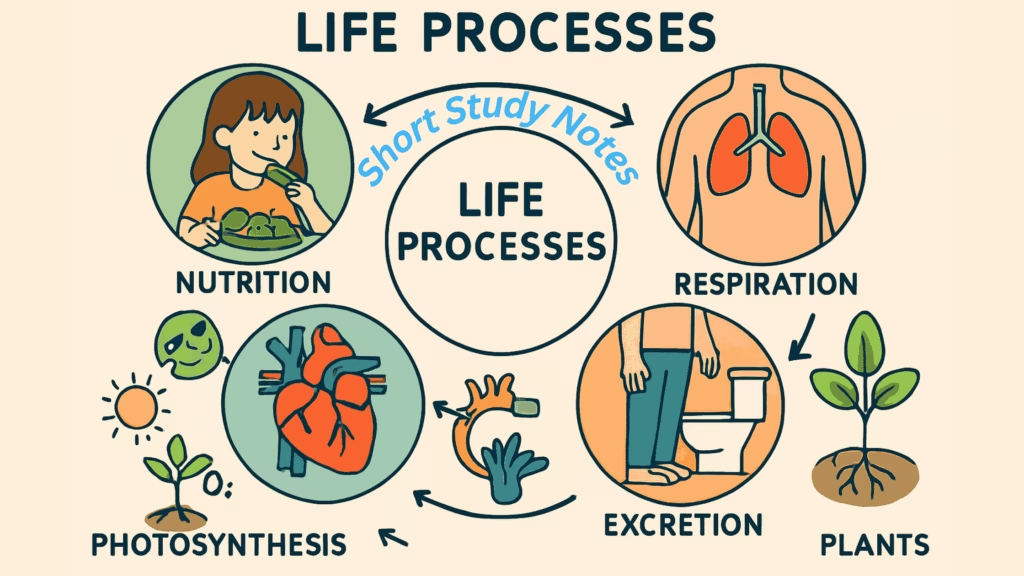
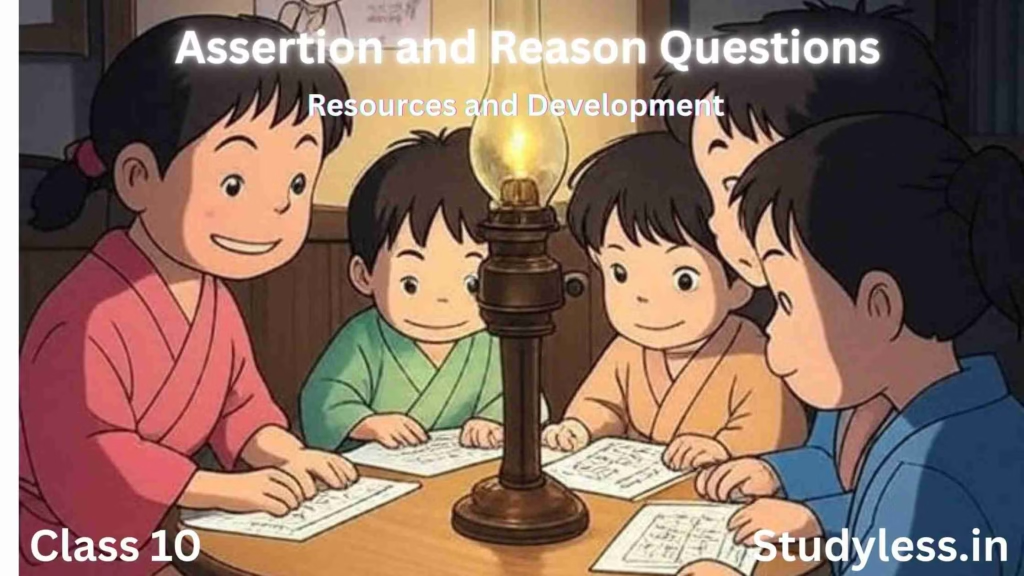
Leave a Comment